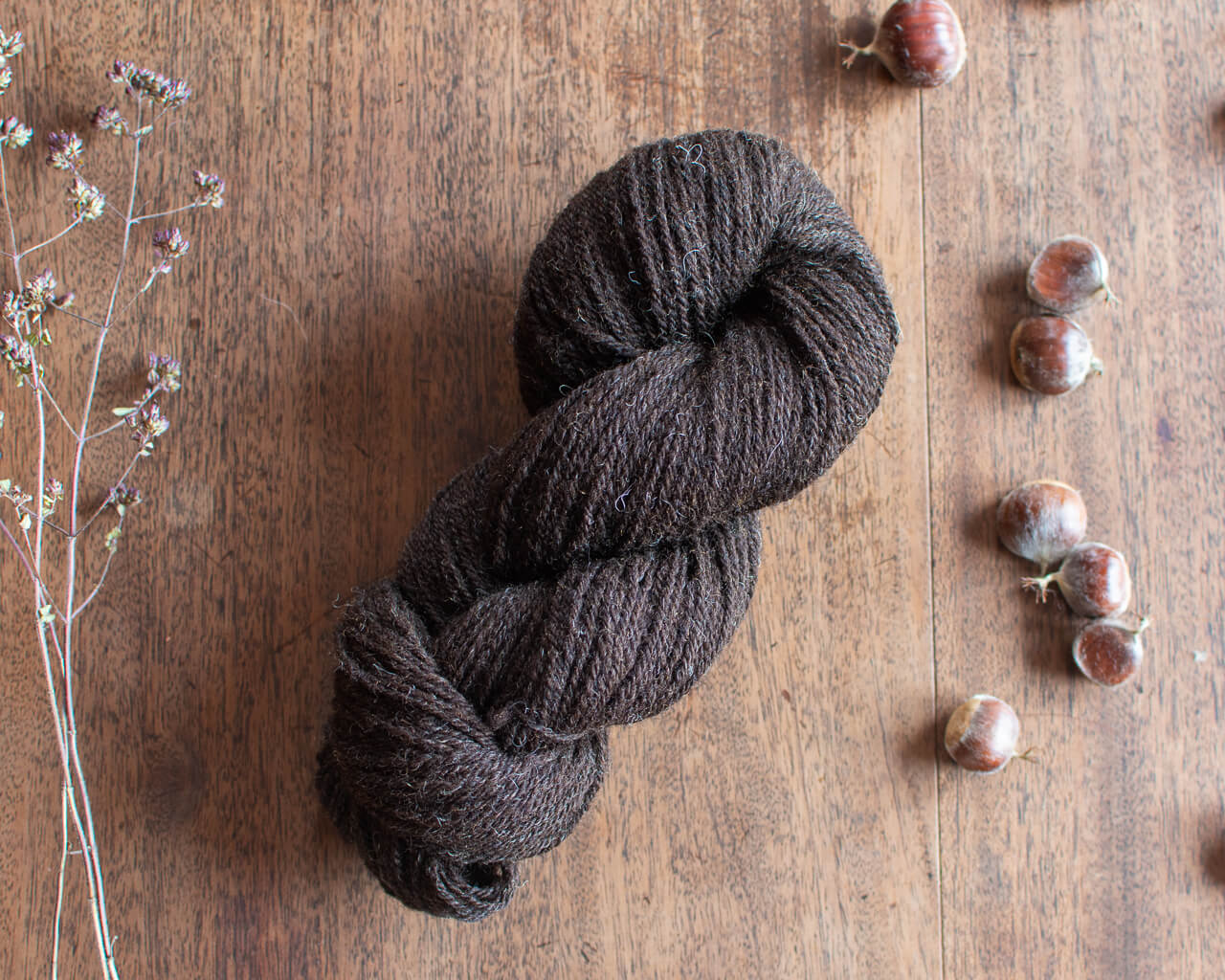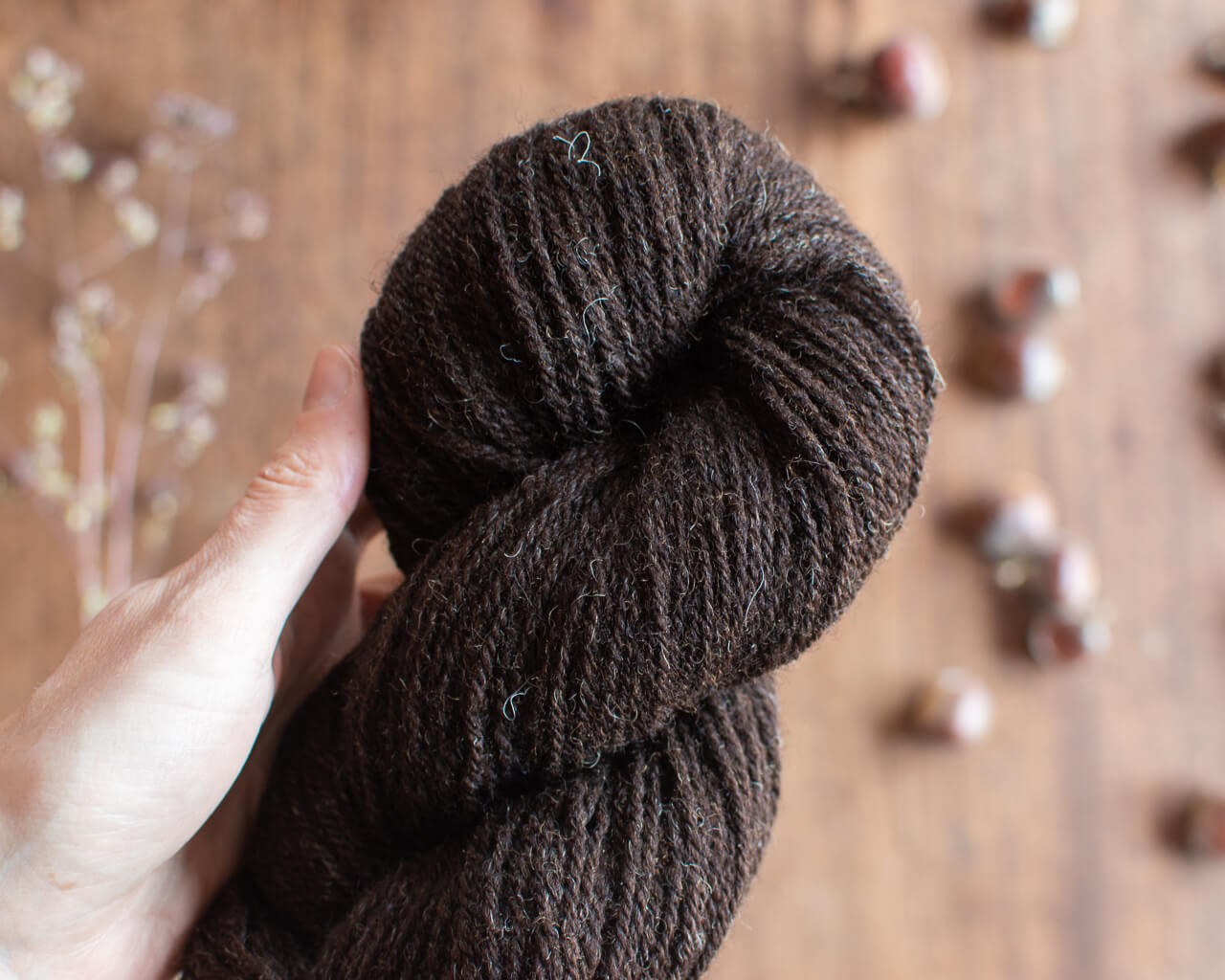I designed a blend of British breeds wool tops for spinning, and wanted to see how the naturally heathered grey wool would take dye. I ended up spinning my dyed sample batch into yarn, then weaving that into cloth and sewing it into an (almost) zero-waste tweedy skirt.
I sewed a skirt out of hand-spun fabric made using hand-dyed British wool fibre
Some ambitious craft projects are meticulously planned right from the very beginning. Others start out as a tiny thing and then… just sort of snowball. In this case, what started as a small dyeing experiment with a new blend of British wool top I designed, somehow turned into an (almost!) zero-waste, handwoven, hand-sewn tweedy skirt!
It’s been a slow craft project, but I documented the entire thing from dyeing the braids of British wool, to spinning it into yarn to weave into a fabric which I then cut and sewed.
Hope you enjoy!

1. Dyeing the wool fibre
Like I said, this ambitious craft project began with my (what was my then new) Skua blend of British wool fibre, a custom spinning fibre I developed in collaboration with Wingham Wool Works. If you’ve followed my work for a while, you’ll likely know it well by now!
My Skua blend is a blend of 5 naturally coloured British sheep breeds (Dorset Horn, Teeswater, Manx Loaghtan, Jacob, and Cheviot), that I designed to combine the qualities I most love in wool for spinning. Together they create a beautiful heathered grey colour with a lovely rustic texture that I think is just perfect for spinning.
Experimenting with hand-dyeing and colour
The aim of this craft project was to test how the Skua blend would take dye for my range of hand-dyed spinning fibres. So, I started in the kitchen with 200g of fibre and a dyepot that was ready for cooking!
For this experiment, I used a resist dyeing method, which involved loosely braiding the fibre into what was essentially a chunky crochet chain. This technique creates natural resist points - areas of fibre where the dye cannot penetrate so deeply, meaning those parts absorb less colour. It’s a relatively simple way to create variegation and depth in hand-dyed fibre, as some parts take on a stronger hue while others are softer and paler, or even stay undyed.
Mixing up my autumnal colour palette
I didn’t have a strict colour plan, I just knew I wanted a palette that felt warm and slightly autumnal. So, working off vibes, I mixed a mustardy, ochre. Starting with some bright lemony yellow and combining it with a little bit of sage green and a tiny bit of terracotta pink, letting them blend and overlap into a sort of warm yellow brown.
I made the dye into a paste with a splash of warm water, then thinned it slightly so it was ready to pour.
Dyeing the spinning fibre
With everything ready, I gently submerged the braided fibre into the prepared dye bath, taking care not to agitate it too much and risk felting the non-superwash fibre. I treated the water before soaking with citric acid to help the dye properly bond to the fibre.
I poured the ochre dye onto one small segment of the dye pot, and on the other, I drizzled in a deep pinky red, aiming for something quite warm and brown overall. I even sprinkled a little pure dye powder directly onto the fibre for extra intensity in some spots.
Once the fibre had been cooking for some time, I left it to cool slowly and soak up all the colour in the pot. The water was completely clear, which is a satisfying sign that all the dye had been absorbed and had fully bonded with the fibre. I transferred the braid into a baby bath to rinse it, undoing the chain carefully to avoid felting.
After a gentle rinse and an overnight dry, I was left with a beautifully variegated wool top: rich rusty orange and dark pinky red, with hints of the natural grey Skua base peeking through.

2. Spinning and weaving my hand-dyed fibre
Over the next couple of weeks, I spun my hand-dyed fibre into a soft, slightly rustic 2-ply yarn. To even out the colours a little and avoid any unexpected pooling, I first split the fibre into little nests before spinning. The resulting yarn ended up somewhere between a 4-ply and a DK weight.
It was around this point that the yarn began to speak to me, telling me it wanted to be woven. Specifically, it wanted to be a skirt. Which could only mean one thing… I needed more yarn.
I spun up a second batch using my undyed Skua fibre to complement the hand-dyed yarn. This combination of dyed and undyed yarns would add some lovely natural variation and depth to the finished hand-spun fabric.
Preparing to weave
To weave my skirt fabric, I used my rigid heddle loom. I decided to use the hand-dyed yarn for the warp, and the undyed yarn would become the weft. I opted for stick shuttles for weaving and warped straight from the balls of yarn.
To keep things balanced, I made notes on the metreage of each ball. I had one slightly heavier and one slightly lighter in both warp and weft, and planned to alternate them throughout the weaving for a more consistent finish. It was always going to be a bit lumpy and bumpy, but that was exactly what I was going for. I like a good bit of rustic cloth!
I chose an 8 EPI heddle (ends per inch), which, for the knitters, is a bit like stitch gauge, i.e. how many warp threads you have per inch. Since my yarn was on the heavier side, I thought 8 EPI would work rather nicely.
Warping my rigged heddle loom
With my hand-spun warp yarn ready, I threaded it directly through the slots in the reed of the heddle, winding it back and forth across the room with a wooden peg on the far end to hold the tension. Once all the warp was in place, I broke the yarn and slowly wound it onto the back beam of the loom, inch by inch, packing it evenly with cardboard strips to keep the layers neat and consistent. Then came the satisfying moment of slicing through the end loops and getting ready to thread the heddles.
The process of lashing on
Once all the heddles were threaded, it was time to lash on, a technique I find especially useful with hand-spun yarns. Rather than tying each small bundle of warp threads individually to the front rod, I used a strong string to zig-zag back and forth over the bundles. This helps keep the tension more even across the warp and uses less yarn overall. Crucial when you’re working with precious hand-spun and every centimetre counts!

Weaving my hand-spun fabric
After the faff of getting my rigged heddle loom ready to weave came the relatively slow and simple act of weaving the cloth itself. This stage of this lengthy craft project was wonderfully simple and soothing. The thicker hand-spun yarn meant the cloth grew quickly on the loom, and I found the rhythm of weaving in the evenings around work incredibly meditative. Within a couple of weeks, my hand-spun fabric was ready to become a skirt.
Once woven, I threw the fabric in the washing machine, and it came out just as I’d hoped - dense, warm, and properly tweedy. Really cosy and blankety, which is exactly what I wanted.

3. Sewing my hand-spun skirt
In total, I had 2.2m of hand-spun fabric at a width just slightly wider than my waist - a very useful fact, as it meant two pieces of fabric would fit around me nicely. It’s precious fabric, so I sketched out the pattern on paper first to map out how best to use every bit.
I cut two strips for the waistband from the top of the length, cutting the back piece in two to allow for a zip closure. The remaining fabric was divided into thirds and pieced together to create the main skirt panel, with inverted box pleats added. The only real scrap left was a small square from the front waistband piece, making this skirt pretty close to zero waste!
I added a lining and reinforced the waistband with interfacing and petersham. This densely woven, non-stretchy ribbon was perfect for supporting the wool and taking some strain off the seams. It was then sewn onto the skirt body along with the zip, which closes at the back. I also stitched a couple of barely visible thread loops and hooks to fasten it neatly at the top. Then, last but not least, I finished the hem, reinforcing it with a long strip of an old bedsheet.
It turned out brilliantly!

A new garment for my handmade wardrobe
I actually finished this project a little while ago, and as I mentioned, I was extremely happy with how it turned out. I’ve been wearing the skirt loads since, and it's already become a bit of a staple in my handmade wardrobe. It’s warm and properly insulating, so it’s perfect for layering up in the colder months, especially with tights and boots. I often pair it with other hand-spun items, too, which makes the whole outfit feel extra special.
There’s something so deeply rewarding about taking this British wool fibre I designed myself and turning it into something beautiful that I can wear. These ambitious craft projects are certainly a long process, seeing it through every stage from dyeing, spinning, weaving and sewing, but I can honestly say it was worth every second.
I hope you agree!

Stay connected with all things Marina Skua.
If you’d like to keep up with everything I’m working on between podcast episodes, please do subscribe to my newsletter. It’s the best way to stay in the loop about events I’ll be attending, shop updates, new product releases, publications, and additions to the website. You also get a 10% discount code with your next order.
I’ve also recently added an events page to the website, where you can see all the upcoming places I’ll be. Whether it’s events I’m attending, talks I’m giving, or markets where you can come and squish some hand-dyed British wool yarns or just have a chat in person.
For more casual life and crafting updates, you can follow me on Instagram, where I’ve been posting a bit more frequently, or join me on Facebook if that’s your preference.
And if you’d like even more behind-the-scenes content, you can join me over on Patreon. Subscribers get loads of extra perks, like early access to limited edition spinning fibre drops, membership in my exclusive Discord group and even (depending on your tier) free knitting patterns and discounts each month!
See you next time.
![Quickbeam cardigan, silly slippers and a finished Pediment in hand-spun yarn [Marina Skua Ep 76]](http://marinaskua.com/cdn/shop/articles/Felted-Slippers-Knitting-Project-Marina-Skua-Knitting-Podcast-Blog_6b7a6b1e-b95a-488f-8915-627a7a87ef4b.jpg?v=1765099041&width=1920)








